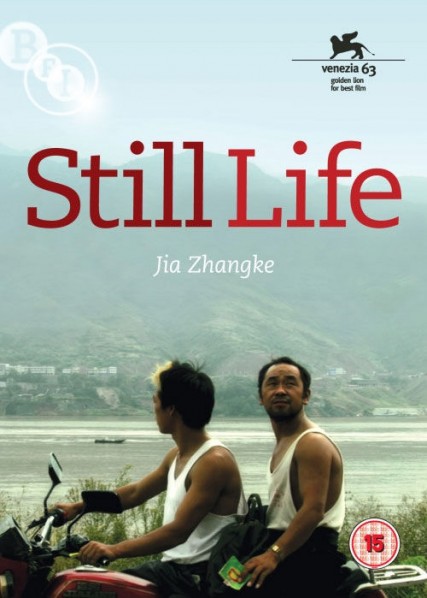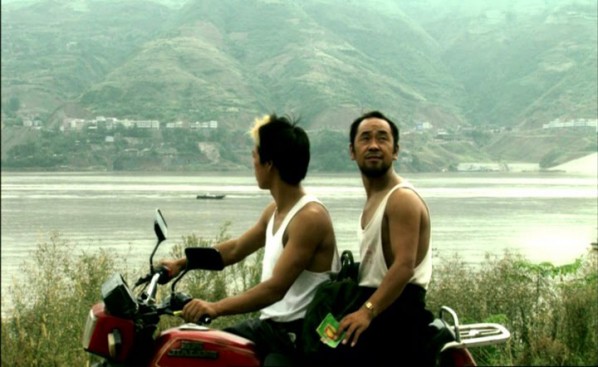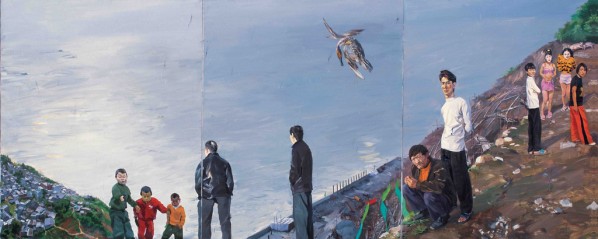
Still Life (Screenshot 04) directed by Jia Zhangke, 2006
by Yin Guannan
In referring to the" Three Gorges" , people will blurt out two distinct words: dam or landscape, the Three Gorges Dam is the achievement of industrial civilization, and the landscape of the Three Gorges is a creature of nature. However, if we combine them with force, name it a rash hydraulic project and begin to give praise to the value it creates and the achievement in promoting economic development, forget its own beauty and ancient history, abandon people who depend on the land around the dam for their survival. Perhaps, people have been well relocated, but the noisy chaos when people moved out and their frequent looking back when they left their homeland were sufficient to show their uncertainty about the future and their love of their homeland.
This sentiment shines in the eyes of the 100 million people and is not completely covered, it was recorded by Jia Zhangke who is known as the "most insightful portrayer of contemporary China ", he positioned his camera there.
In general, a film has two kinds of genre: dramatic or prose.
More contemporary films tend to be dramatic, especially in vogue are the "legendary" movie and the "wonder" movie, which goes far beyond life. But Jia Zhangke sticks to the prose playwriting
Structure focusing on common stories. The "Still Life" created on 2004 won the "Golden Lion Award" at the 63rd Venice Film Festival. Jia Zhangke uses his camera to record ordinary people, especially marginalized people, recording their life story, calm but intriguing.

Poster of "Still Life" directed by Jia Zhangke, 2006
"Kind People at the Three Gorges", with the English name of "Still life", still life? still object ? Why was it so named? Can it also have another significance? With this question, the story starts. The beginning of the movie describes hundreds of people crowded on the narrow bottom of a scow at eye-level perspective, the droning whistle of boats and the beautiful background acts as an extension of the lens for up to four minutes, immediately taking the audience into the dead and restless world formed by numerous ordinary lives. The film follows two themes: First, the coal miner Han Sanming who comes to the Three Gorges to find his wife which he bought six years ago and their daughter, they meet and eventually decide to remarry. In this theme, the plot is depicted mostly by naked busts of middle-aged men including naked busts crowded in a cabin , naked squat busts having dinner in a small hotel and naked sweaty busts at a worksite ,these straightforward bodies are the epitome of the monotonous life of the local general public or migrant workers. Oily skin seems to fight against a pale soul which reminds us that they are alive. Jia Zhangke pays attention to the marginalized people and records their living shadows through the camera lens.

Still Life (Screenshot 02) directed by Jia Zhangke, 2006

Still Life (Screenshot 03) directed by Jia Zhangke, 2006
Jia Zhangke lays particular stress on the living conditions of the people living in poverty and an important feature for them is their lack of voice, the poor are the silent majority which is in reality the underprivileged class. Jia Zhangke once said: “what each time of change damages is the interests of all the pipsqueaks and is at the expense of sacrificing them."

Still Life (Screenshot 06) directed by Jia Zhangke, 2006

Still Life (Screenshot 07) directed by Jia Zhangke, 2006
The second theme is of nurse Zhao Tao from Shanxi who goes to the Three Gorges to find her husband who she has not been out of touch with for two years, the two meet in the river and after a romantic dance, they sadly divorce. If Han Sanming’s wife is full of hope and fearless, then Zhao Tao's husband is more like a deported person with a yoke enforced by emotion, in describing this relationship, Jia Zhangke doesn't emphasize the female's distraught mood, but transforms the passive feeling of failure as she has taken the initiative to contact her husband after two years into a kind of feeling of relief, a feeling of rushing to enjoy the state of getting rid of the yoke .
This is different from the people Jia Zhangke has described previously who passively accept their fate, these people's self-awareness begins to strengthen under the condition of the hard to change environment which he understands as the dignity of man, as a result, the very act of using her initiative in "finding" acts as a major element to enhance the spiritual description of the place. So it is not difficult to offer a new explanation to "still life". In my opinion, what Jia Zhangke would like is to express "live life", life is equal for all.
Many contemporary artists' thinking shown as pseudo-philosophers is more like artificial thinking, as they do not really care about things around them. Still Life's difference lies in the basis of respecting "primitive" things .Examining the world through the eyes' of philosophers, revealing society at the point of sociologists and showing the way of artists, Jia Zhangke is a remarkable artist.

Still Life (Screenshot 08) directed by Jia Zhangke, 2006

"New Immigrants of Three Gorges Dam" by Liu Xiaodong
Representation of the ordinary people and their stories impress us like a fresh "primitive" realisation, Jia Zhangke's concern with "primitive" is a return to the past which concludes with a respect for life, thinking of humanity and social responsibility. He said: "The art is to recognize your sickness, and then describe the feeling of pain." Artist Liu Xiaodong also constructs a description of pain, his works "New Immigrants of Three Gorges Dam" and "Hot House" were created at the same time as "Still Life ". Figures in "New Immigrants of Three Gorges Dam" are small but also great, small refers to their confusion when their home was submerged, and greatness lies in their hardy character in carrying on with life; The naked squat in" Hot House" is not only a kind of deep power but also a kind of helpless grief which shows man's robust physique and love of youth and life at the same time. People who are familiar with Liu Xiaodong can easily find that he usually draws directly from nature and most of his works are scrolls, full of "primitive" feeling. "I think that the composition of traditional Western art is too focused that it looks like a drama, but life itself is just like walking in a scroll, to watch while walking, it needs time to understand and to gradually experience, so the scroll is closer to life."
Artists who focusing on life and take up the mission of the time would shuttle between several roles as artist, sociologist and even philosopher raise the "issues around us" one by one. Issues happen between us, maybe not every time, both film and painting can touch the wound and clean the mind, just like a "primitive" song which floats into reality is deceived by dirt when it moves into our inner world.
About the Author
Yin Guannan
Born in 1991, Currently living and studying in Beijing.
Now a junior student in Art History Department of Humanities Institute , Central Academy of Fine Arts, Beijing;
Also a contributing editor of the Art Entrance Magazine.
The views expressed in this column are the author’s own and do not represent those of CAFA ART INFO.




























